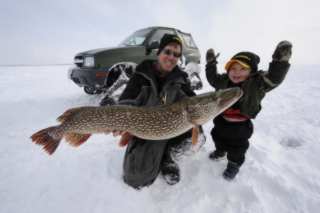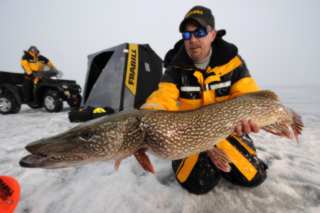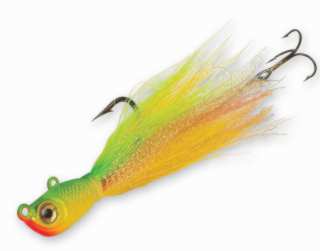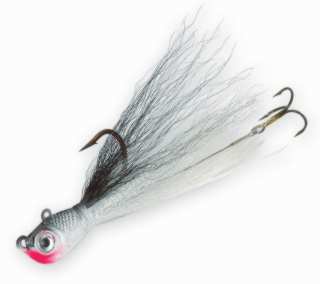| Up above, I tiptoe across the frozen shallows maintaining
a low profile. Stealth is a big part of the game. Down below,
however, it’s more like lions in the Coliseum tearing
and tossing-down everything with blood running through its
veins. That’s what it’s like in early winter
when northern pike slash through the shallows with hearty
appetites and an equal amount of recklessness.
These apex predators spent most of late autumn roaming
the basin, tracking along offshore humps and deeper secondary
breaks. With the flip of a switch, though, they head straight
for the shallows – 4 to 12 feet of water –
when the surface water solidifies. And there’s no
secret to the gravitational pull. It’s about gorging
on the bounty of available forage.
Panfish are standard fare. Bluegills, crappies, and perch
are already making use of whatever green weeds are left.
There, they find food, and, allegedly, sanctuary from
threats. Pike disrupt the peace, however, ferreting through
cuts and openings, as well as cruising along the edge
picking off the careless. Ultimately, panfish only find
safety in numbers, some brethren sacrificed for the whole.
On certain lakes and reservoirs the summons comes in
the form of whitefish and or tullibee (ciscoes). Their
reproductive ritual begins in the late fall and finalizes
sometime after first ice. Perfect timing for pike.

Yet another tape-measure pike falls
to a Northland Bionic Bucktail Jig and live sucker
minnow. This jaw-dropping specimen was caught
in less than 10-feet of water on Minnesota’s
Lake of the Woods out of Arnesen’s Rocky
Point Resort. Photo courtesy of Bill Lindner Photography
|

A comprehensive plan for early ice
pike includes both jigging tactics and a strategic
array of remote setlines, tip-ups. This colorful
beast couldn’t resist a live shiner struggling
for life beneath a Frabill Pro Thermal Tip-Up.
Photo courtesy of Bill Lindner Photography
|
So the foodstuffs are up in the shallows, but located
randomly. Weeds have already been noted. But make sure
your focusing on the greenest and thickest vegetation
available. That could mean a lush garden grove. In other
situations it’s a thick spot amongst an acre of
spindly brown weeds. The most reliable weeds are found
in shallow bays that are adjacent to the main lake.
River mouths are another natural draw. Pike are suckers
for moving water. Suckers, the actual fleshy baitfish,
are common there. Take heed that ice quality on and around
river mouths is several notches thinner than what the
main lake offers.
Although pike activity is at its seasonal peak, there
are good, better, and best times to fish. Morning and
evening are no-brainers. With that said, historically,
I’ve nailed the majority of my larger fish –
10-pounds plus – during mid to late morning, say
from 8 to 11 am. The last hour and a half of the day is
next in importance, but a distant second.
Weather is a factor as well. Invariably, I pound more
pike on cloudy days than those marked with sunshine. Pike
roam more freely. They loosen their range and don’t
stick as tightly to cover. In response, I spread the field,
which means running Frabill tip-ups while maintaining
a rigorous jigging schedule. Depending on the state’s
legal allotment of lines and how many partners I’m
sharing the ice with, it can be half-dozen tip-ups sprinkled
about a 200 foot radius.
The only thing that bests cloud cover is cloud cover
on the leading edge of imminent precipitation, either
snow or one of those bothersome early winter mists. Pike
go bonkers before a front.
Now about that tiptoeing and black-ops stealth I mentioned
earlier… Yes, early winter pike are ferocious feeders.
That’s to your advantage. But on the flipside, you’re
operating in shallow water with only a thin veil of early
ice. The ice, in fact, is often transparent. To the fish,
you’re silhouette is as apparent as the old tire
and boulder on the bottom you just walked over. Complicating
matters, my preferred technique positions me directly
over their heads.
Jigging really scratches their itch, though. When pike
are on the move an energetic jig is irresistible.
Pre-drilling puts the angler in position to operate stealthily.
Drill your holes 15 minutes to a half hour before show
time. To really take advantage of the morning bite, pre-drill
in the darkness, before pike take their morning swim.
Finally, it’s fishing time. Lurched over a hole,
I ready the rig, which was tied-up the night before. There’s
no finer opening act than an oversized jig fitted with
a live sucker minnow, either. My preference is the Bionic
Bucktail Jig from Northland Fishing Tackle. Hand-tied
with genuine bucktail, the Bionic Bucktail creates a full-figured
and vibrant target. In clear water, I opt for White Cisco,
as it mimics most native baitfish. In darker conditions,
Yellow Perch is a better choice.

Bro opts for the Yellow Perch patterned
Northland Bionic Bucktail Jig when fishing stained
water or the forage-base is known to consist of
perch and or sunfish. Photo courtesy of Northland
Fishing Tackle (www.northlandtackle.com
|

Bro says the White Cisco flavored
Northland Bionic Bucktail Jig accurately mimics
foodstuffs such as whitefish, ciscoes, suckers
and lake shiners. Photo courtesy of Northland
Fishing Tackle (www.northlandtackle.com
|
Next comes a 4-inch sucker minnows or chub – they
are the ideal length and shape for jigging pike. Lip-hook
the minnow with the forged single hook. The rear of the
jig features a “sting’r” hook, a treble
tethered by teeth-resistant steel. Don’t stick the
treble in the bait’s posterior. It’s a common
practice, but I’ve stung more pike with it floating
freely alongside the minnow. My theory is that the lightest
part of the rig – the sting’r in this case
– is the first to find a pike’s jaw.
The action is more of a swimming and dumbed-down-darting
than classic jigging. Don’t snap it. Instead, smoothly
but confidently pump the jig in 1 to 2-foot motions. I’ll
operate from top to bottom in clear conditions. Pike aren’t
bashful about rising to the underside of the ice. In darker
water, I’ve found most fish operate within 4-feet
of the bottom.
Not just any old rod will do, either. Put away the panfish
stuff. Remember, you’re tangling with muscle-bound
fish in a relatively small space. It’s fist to fin
combat.
A guiding buddy of mine and northern pike nemesis, Paul
Nelson, developed a pike-specific rod for Frabill. It’s
quite the fish tamer. Found in the Ice Hunter series,
the 32-inch, medium-heavy stick yields the perfect balance
of a firm but playful tip with the backbone of a brontosaurus.
For battling in tight-quarters I recommend spooling with
a superline, not monofilament or fluorocarbon. You’ll
appreciate the toughness and resistance to shredding.
I look forward to testing the new Performance Fuse from
Sufix.
It takes angler skill to bring down fish of this magnitude
as well. Expect violent runs and very dynamic directional
changes. To win, you must wear the fish out, no horsing
it in. Pulling back too hard nearly insures that the jig
will tear free. Maintain pressure, letting the drag do
what it’s designed to do. As a failsafe, I back-reel
with the drag-system covering my behind. If the fish runs
exceptionally fast, lock down on the handle and the drag
takes over – beautiful 2-part harmony.
Icing a submarine-sized pike in the shallows isn’t
like walking and chewing gum. Plan that the fish will
appear horizontally – wide head in the hole and
numerous inches of body tucked beneath ice. Keep the rod
loaded, applying constant pressure while turning the fish.
Obviously, it’s nice having a “net man”.
As the snout rises, prepare for the snatch and grab. Know
that you’re going to get wet. In fact, to reduce
the risk of breaking off, I take the fish while it’s
vertical, its movement restricted in the hole. As a bonus,
the fish is less likely to flip-out and injure itself.
Once on the ice, it’s a quick photo – titans
only – and the head goes back from where it came.
Hold and pump the fish a few times until it’s self-powered.
High-five your partner, or do that faddish knocking fists
move, and it’s on to another screensaver quality
pike.
About the author: Brian “Bro” Brosdahl (Max,
Minnesota) is a professional fishing guide and renowned
ice fishing expert. For nearly two decades he’s
been sharing his insights and innovations with the fishing
public. He can be reached at bbro@paulbunyan.net.
|



